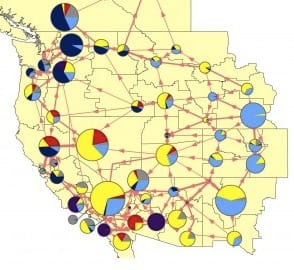Solar power could supply one-third of the West’s power needs by 2050 if federal cost-reduction targets are met and the region adopts reasonable carbon policies, according to a new study from researchers at the University of California, Berkeley.
The cost of solar has been declining rapidly, and it has proliferated in use faster than many thought possible. The U.S. recently became one of four other countries to reach 10 gigawatts of solar capacity. Still, it has barely crested one percent of total energy production in the United States. As the twin trends of lower cost and increased distribution accelerate, the stark reality remains: transitioning the electric grid more completely to renewables could be expensive and difficult.
The Berkeley study, published in Environmental Science and Technology, analyzed how widespread solar could reasonably become in western North America by mid-century. They developed a model that determined the optimal investment of solar generation, transmission, and storage across the Western Electricity Coordinating Council (WECC). This is the grid rich with renewable resources that serves 14 Western states, plus British Columbia, Alberta, and northern Baja California in Mexico. That richness in intermittent renewable power, plus the large geographic size of the grid, makes the WECC an ideal place to examine how renewable power such as solar would actually scale.
The crucial factor in the study was the impact of solar cost-reduction targets on the broader energy mix. The Department of Energy’s SunShot Initiative was announced in 2011 with the goal of reducing total solar costs by 75 percent by 2020, to be cost-competitive with other large-scale forms of energy without subsidies. The name is a play on President Kennedy’s “moon shot” goal he set, to get Americans on the moon. Since its inception, the program has supported next-generation photovoltaic cells, such as “multijunction cells” that boost efficiency, as well as efforts to reduce the “soft costs” of solar installation like financing hurdles and simplifying installation technology. If successful, the price of solar would drop to a dollar a watt, or 6 cents a kilowatt-hour — right on par with conventional fossil fuel energy without subsidies.
Recent analyses place the current levelized cost of installed solar between 19 and 24 cents per kilowatt-hour, depending on the location.
The researchers examined several different scenarios, but the most interesting one was the “Limited Technology SunShot Scenario,” which analyzed what would happen if: the region agreed to a carbon cap that would reduce emissions to 80 percent of 1990 levels by 2050, nuclear and carbon capture and sequestration technologies were not available as investment options, and the Department of Energy’s SunShot Initiative was successful.
In this scenario, the region would rely on large-scale wind deployment for 34 percent of its power, and solar generation for 30 percent. Geothermal would provide low-carbon baseload generation, and hydropower and natural gas generation would be used for the rest of the mix, allowing for additional grid flexibility. This is what would be powering North American power outlets by 2050 in this scenario:
Notice the huge amount of solar streaming out of the Southwest, geothermal in the mountains, wind off the plains (even in tar sands-soaked Alberta), and the hydro power centers in the Northwest. This would mean more large-scale installations like the 377 megawatt Ivanpah concentrated solar plant in the Mojave desert — scheduled to come online by the end of 2013. The scenario envisions 5 gigawatts of concentrated solar power with 6 hours of storage installed in California, which would mean about a dozen more Ivanpahs. Distributed photovoltaic solar systems could help reduce transmission costs. Small increases in storage technology would help charge the grid with peak power generation in the sunny middle of the day for use in the peak-demand late evening.
Costs increase in all four scenarios, yet relying on the status quo of predominantly fossil fuel-based electric power would be economically, socially, and environmentally expensive. According to the Berkeley researchers, the cost of electricity would be lower with a successful implementation of new nuclear power and carbon capture and sequestration (CCS) technology. However, because both nuclear power and CCS are expensive and risky, the Limited Technology Scenario without both of these technologies is the most feasible option.
While these targets may seem overlay ambitious to some, states are already finding success in beating existing renewable energy goals. Minnesota Power recently announced it will reach its 25 percent renewable energy quota ten years early.
Finally, the study concludes that dropping the cost of solar to $1 per watt mitigates the cost of the carbon cap in the WECC. As the study’s authors put it: “Achieving the SunShot target could make it cost-effective for solar power to provide more than a third of electricity in the WECC by 2050, aiding the ability of the WECC power system to reduce emissions while meeting load.” Cutting carbon becomes feasible and costs nothing if a program like the SunShot Initiative succeeds.
This article was originally published on Climate Progress. Reproduced with permission











